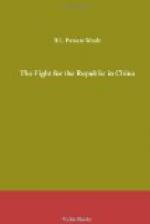On the 28th June a long funeral procession wended its way from the Presidential Palace to the railway station; it was the remains of the great dictator being taken to their last resting-place in Honan. Conspicuous in this cortege was the magnificent stagecoach which had been designed to bear the founder of the new dynasty to his throne but which only accompanied him to his grave. The detached attitude of the crowds and the studied simplicity of the procession, which was designed to be republican, proved more clearly than reams of arguments that China—despite herself perhaps—had become somewhat modernized, the oldest country in the world being now the youngest republic and timidly trying to learn the lessons of youth.
Once Yuan Shih-kai had been buried, a Mandate ordering the summary arrest of all the chief monarchist plotters was issued; but the gang of corrupt men had already sought safety in ignominious flight; and it was understood that so long as they remained on soil under foreign jurisdiction, no attempt would be made even to confiscate their goods and chattels as would certainly have been done under former governments. The days of treachery and double-dealing and cowardly revenge were indeed passing away and the new regime was committed to decency and fairplay. The task of the new President was no mean one, and in all the circumstances if he managed to steer a safe middle course and avoid both Caesarism and complete effacement, that is a tribute to his training. Born in 1864 in Hupeh, one of the most important mid-Yangtsze provinces, President Li Yuan-hung was now fifty-two years old, and in the prime of life; but although he had been accustomed to a military atmosphere from his earliest youth his policy had never been militaristic. His father having been in command of a force in North China for many years, rising from the ranks to the post of tsan chiang (Lieutenant-Colonel), had been constrained to give him the advantage of a thoroughly modern training. At the age of 20 he had entered the Naval School at Tientsin; whence six years later he had graduated, seeing service in the navy as an engineer officer during the Chino-Japanese war of 1894. After that campaign he had been invited by Viceroy Chang Chih-tung, then one of the most distinguished of the older viceroys, to join his staff at Nanking, and had been entrusted with the supervision of the construction of the modern forts at the old Southern capital, which played such a notable part in the Revolution. When Chang Chih-tung was transferred to the Wuchang viceroyalty, General Li Yuan-hung had accompanied him, actively participating in the training of the new Hupeh army, and being assisted in that work by German instructors. In 1897 he had gone to Japan to study educational, military and administrative methods, returning to China after a short stay, but again proceeding to Tokyo in 1897 as an officer attached to the Imperial Guards. In the autumn of the following year he had returned to




